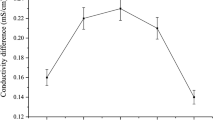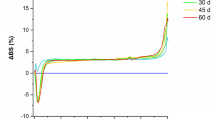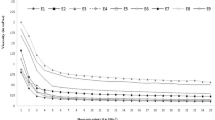Abstract
Vitamin E (VE) is highly lipophilic in nature with a very low water solubility which degrades rapidly in presence of oxygen, and free-radical mediated oxidative processes. Spray drying of oil-in-water emulsions containing hydrophilic carriers was used to encapsulate lipophilic compounds into powders. The purpose of this study was to prepare microcapsules of VE using different starch derivatives to increase its stability and to disperse it in aqueous environment. Emulsion of VE acetate was prepared using cremophore RH 40 with tween 80 in a homogenizer and then spray dried. The spray process was optimized using a central composite design for two variables to obtain microcapsules with desirable characteristics. Microcapsules containing 2, 4 and 6% w/w of VE acetate were produced. The microcapsules were evaluated for their physical, morphological, in vitro release, solid state characterization such as SEM, FTIR, P-XRD and its in vitro free radical scavenging activity. The results showed that obtained microcapsules are nearly spherical in shape with mean particle size of microcapsules were ranged from 1 to 12 µm. The drug content and encapsulation efficiency (53–63%) was found to be uniform and within acceptable range. Optimized formulations were kept for 3 months stability study and found to be stable.








Similar content being viewed by others
References
Abayomi M, Adebayo AS, Bennett D, Porter R, Campbell JS, Dawkin G (2014) Phytochemical testing and in vitro antibacterial activity of Bixa orellana (Annatto) seed extract. Br J Pharm Res 4:1387–1399
Bae E, Lee S (2008) Microencapsulation of avocado oil by spray drying using whey protein and maltodextrin. J Microencapsul 25:549–560
Baschong W, Artmann C, Hueglin D, Roeding J (2000) Direct evidence for bioconversion of vitamin E acetate into vitamin E: an ex vivo study in viable human skin. J Cosmet Sci 52:155–161
Basnet P, Hussain H, Tho I, Skalko-Basnet N (2012) Liposomal delivery system enhances anti-inflammatory properties of curcumin. J Pharm Sci 101:598–609
Chiu Y, Chiu C, Chien J, Ho G, Yang J, Chen B (2007) Encapsulation of lycopene extract from tomato pulp waste with gelatin and poly (γ-glutamic acid) as carrier. J Agric Food Chem 55:5123–5130
de Vos P, Faas MM, Spasojevic M, Sikkema J (2010) Encapsulation for preservation of functionality and targeted delivery of bioactive food components. Int Dairy J 20:292–302
Ersus S, Yurdagel U (2007) Microencapsulation of anthocyanin pigments of black carrot (Daucus carota L.) by spray drier. J Food Eng 80:805–812
Gangurde AB, Fule RA, Javeer SD, Patole RK, Pawar JN, Amin PD (2015) Microencapsulation using aqueous dispersion of lipid matrix by fluidized bed processing technique for stabilization of choline salt. J Pharm Investig 45:209–221
Gawrysiak-Witulska M, Siger A, Nogala-Kalucka M (2009) Degradation of tocopherols during near-ambient rapeseed drying. J Food Lipids 16:524–539
Gonnet M, Lethuaut L, Boury F (2010) New trends in encapsulation of liposoluble vitamins. J Control Release 146:276–290
Hategekimana J, Masamba KG, Ma J, Zhong F (2015) Encapsulation of vitamin E: effect of physicochemical properties of wall material on retention and stability. Carbohydr Polym 124:172–179
Landvik S (2004) Vitamin E from supplements has good bioavailability. Am J Clin Nutr 80:784–785
Lauridsen C, Hedemann MS, Jensen SK (2001) Hydrolysis of tocopheryl and retinyl esters by porcine carboxyl ester hydrolase is affected by their carboxylate moiety and bile acids. J Nutr Biochem 12:219–224
Leonard SW, Good CK, Gugger ET, Traber MG (2004) Vitamin E bioavailability from fortified breakfast cereal is greater than that from encapsulated supplements. Am J Clin Nutr 79:86–92
Lesmes U, McClements DJ (2009) Structure–function relationships to guide rational design and fabrication of particulate food delivery systems. Trends Food Sci Technol 20:448–457
López AF, Deladino L, Alba SN, Miriam NM (2011) Encapsulación de compuestos bioactivos con alginatos para la industria de alimentos. @ limentech, Ciencia y Tecnología Alimentaria 10
Marchal L, Beeftink H, Tramper J (1999) Towards a rational design of commercial maltodextrins. Trends Food Sci Technol 10:345–355
McClements DJ, Decker EA, Park Y, Weiss J (2009) Structural design principles for delivery of bioactive components in nutraceuticals and functional foods. Crit Rev Food Sci Nutr 49:577–606
Pierucci APT, Andrade LR, Farina M, Pedrosa C, Rocha-Leão MHM (2007) Comparison of α-tocopherol microparticles produced with different wall materials: pea protein a new interesting alternative. J Microencapsul 24:201–213
Pu J, Bankston JD, Sathivel S (2011) Developing microencapsulated flaxseed oil containing shrimp (Litopenaeus setiferus) astaxanthin using a pilot scale spray dryer. Biosyst Eng 108:121–132
Rattes ALR, Oliveira WP (2007) Spray drying conditions and encapsulating composition effects on formation and properties of sodium diclofenac microparticles. Powder Technol 171:7–14
Reineccius GA (1991) Carbohydrates for flavor encapsulation. Food Technol 45:144–146
Risch SJ, Reineccius G (1988) Flavor encapsulation, ACS symposium series (USA). American Chemical Society, Washington, DC
Rosenberg M, Kopelman I, Talmon Y (1990) Factors affecting retention in spray-drying microencapsulation of volatile materials. J Agric Food Chem 38:1288–1294
Sadeghi A, Shahidi F, Mortazavi SA, Mahalati MN (2008) Evaluation of different parameters effect on maltodextrin production by–amylase Termamyl 2-x. World Appl Sci J 3:34–39
Sagalowicz L, Leser M, Watzke H, Michel M (2006) Monoglyceride self-assembly structures as delivery vehicles. Trends Food Sci Technol 17:204–214
Sansone F, Mencherini T, Picerno P, d’Amore M, Aquino RP, Lauro MR (2011) Maltodextrin/pectin microparticles by spray drying as carrier for nutraceutical extracts. J Food Eng 105:468–476
Schafroth N, Arpagaus C, Jadhav UY, Makne S, Douroumis D (2012) Nano and microparticle engineering of water insoluble drugs using a novel spray-drying process. Colloids Surf B 90:8–15
Shahidi F, Han XQ (1993) Encapsulation of food ingredients. Crit Rev Food Sci Nutr 33:501–547
Traber MG, Sies H (1996) Vitamin E in humans: demand and delivery. Annu Rev Nutr 16:321–347
Tuyen CK, Nguyen MH, Roach PD (2010) Effects of spray drying conditions on the physicochemical and antioxidant properties of the Gac (Momordica cochinchinensis) fruit aril powder. J Food Eng 98:385–392
Velikov KP, Pelan E (2008) Colloidal delivery systems for micronutrients and nutraceuticals. Soft Matter 4:1964–1980
Xu J, Bovet LL, Zhao K (2008) Taste masking microspheres for orally disintegrating tablets. Int J Pharm 359:63–69
Yoon Y, Choe E (2009) Lipid oxidation and stability of tocopherols and phospholipids in soy-added fried products during storage in the dark. Food Sci Biotechnol 18:356–361
Acknowledgements
This article does not contain any studies with human and animal subjects performed by any of the authors. All authors (AB Gangurde, Meer T. Ali, Jaywant N. Pawar and PD.Amin) declare that they have no conflict of interest. The authors are thankful to BASF Pvt. Ltd., India for providing the gift sample of VE acetate. The authors are also thankful to UGC-SAP-2801-PH for providing the research fellowship.
Conflict of interest
Author declares that we do not have any conflict of interest.
Author information
Authors and Affiliations
Corresponding author
Rights and permissions
About this article
Cite this article
Gangurde, A.B., Ali, M.T., Pawar, J.N. et al. Encapsulation of vitamin E acetate to convert oil to powder microcapsule using different starch derivatives. Journal of Pharmaceutical Investigation 47, 559–574 (2017). https://doi.org/10.1007/s40005-016-0287-3
Received:
Accepted:
Published:
Issue Date:
DOI: https://doi.org/10.1007/s40005-016-0287-3




